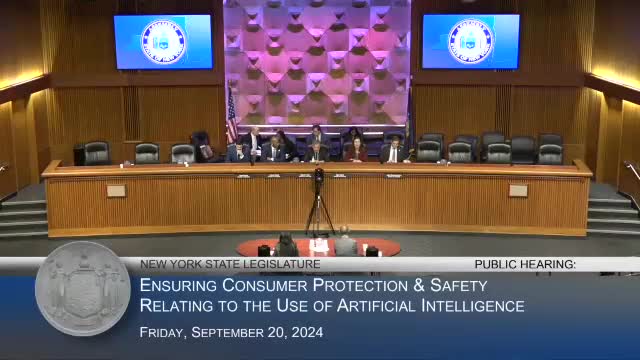Assemblywoman Rosick leads New York hearing on AI consumer protection legislation
September 20, 2024 | Consumer Affairs and Protection, Standing Committees, House, Legislative, New York
This article was created by AI summarizing key points discussed. AI makes mistakes, so for full details and context, please refer to the video of the full meeting. Please report any errors so we can fix them. Report an error »

Under the bright lights of the New York State Legislature, a pivotal conversation unfolded on September 20, 2024, as lawmakers gathered to address the pressing issue of consumer protection in the age of artificial intelligence (AI). Assemblywoman Neli Rosick, chair of the Committee on Consumer Protection, opened the hearing with a warm welcome, emphasizing the relevance of AI in reshaping daily life—from shopping habits to health management.
Rosick highlighted the dual nature of AI, acknowledging its potential for increased efficiency and personalized services while also recognizing the significant challenges it poses. She pointed to recent developments in California, where new consumer protection regulations were enacted, setting the stage for New York's own discussions on how to safeguard its residents in this rapidly evolving technological landscape.
Assemblymember Steve Otis, co-chair of the hearing, echoed Rosick's sentiments, noting the importance of timely regulation. He remarked on the global competition surrounding AI and the necessity for New York to establish robust protections against privacy breaches and biases that could arise from AI systems. Otis stressed the urgency of keeping pace with technological advancements, drawing parallels to past regulatory challenges faced in the realm of social media.
As the hearing progressed, the legislators were joined by experts from the New York Attorney General's Office, including Chris D'Angelo and Darsana Srinivasan, who were prepared to provide insights on ensuring consumer safety in AI applications. Their participation underscored the collaborative effort between government and legal experts to navigate the complexities of AI regulation.
The discussions at this hearing mark the beginning of a crucial dialogue in New York, as lawmakers seek to balance innovation with consumer rights. With AI's rapid evolution, the stakes are high, and the decisions made today will shape the future landscape of technology and consumer protection in the state. As the meeting concluded, the sense of urgency lingered in the air, leaving attendees aware that the path forward would require careful consideration and proactive measures to protect the public in an increasingly digital world.
Rosick highlighted the dual nature of AI, acknowledging its potential for increased efficiency and personalized services while also recognizing the significant challenges it poses. She pointed to recent developments in California, where new consumer protection regulations were enacted, setting the stage for New York's own discussions on how to safeguard its residents in this rapidly evolving technological landscape.
Assemblymember Steve Otis, co-chair of the hearing, echoed Rosick's sentiments, noting the importance of timely regulation. He remarked on the global competition surrounding AI and the necessity for New York to establish robust protections against privacy breaches and biases that could arise from AI systems. Otis stressed the urgency of keeping pace with technological advancements, drawing parallels to past regulatory challenges faced in the realm of social media.
As the hearing progressed, the legislators were joined by experts from the New York Attorney General's Office, including Chris D'Angelo and Darsana Srinivasan, who were prepared to provide insights on ensuring consumer safety in AI applications. Their participation underscored the collaborative effort between government and legal experts to navigate the complexities of AI regulation.
The discussions at this hearing mark the beginning of a crucial dialogue in New York, as lawmakers seek to balance innovation with consumer rights. With AI's rapid evolution, the stakes are high, and the decisions made today will shape the future landscape of technology and consumer protection in the state. As the meeting concluded, the sense of urgency lingered in the air, leaving attendees aware that the path forward would require careful consideration and proactive measures to protect the public in an increasingly digital world.
View full meeting
This article is based on a recent meeting—watch the full video and explore the complete transcript for deeper insights into the discussion.
View full meeting
